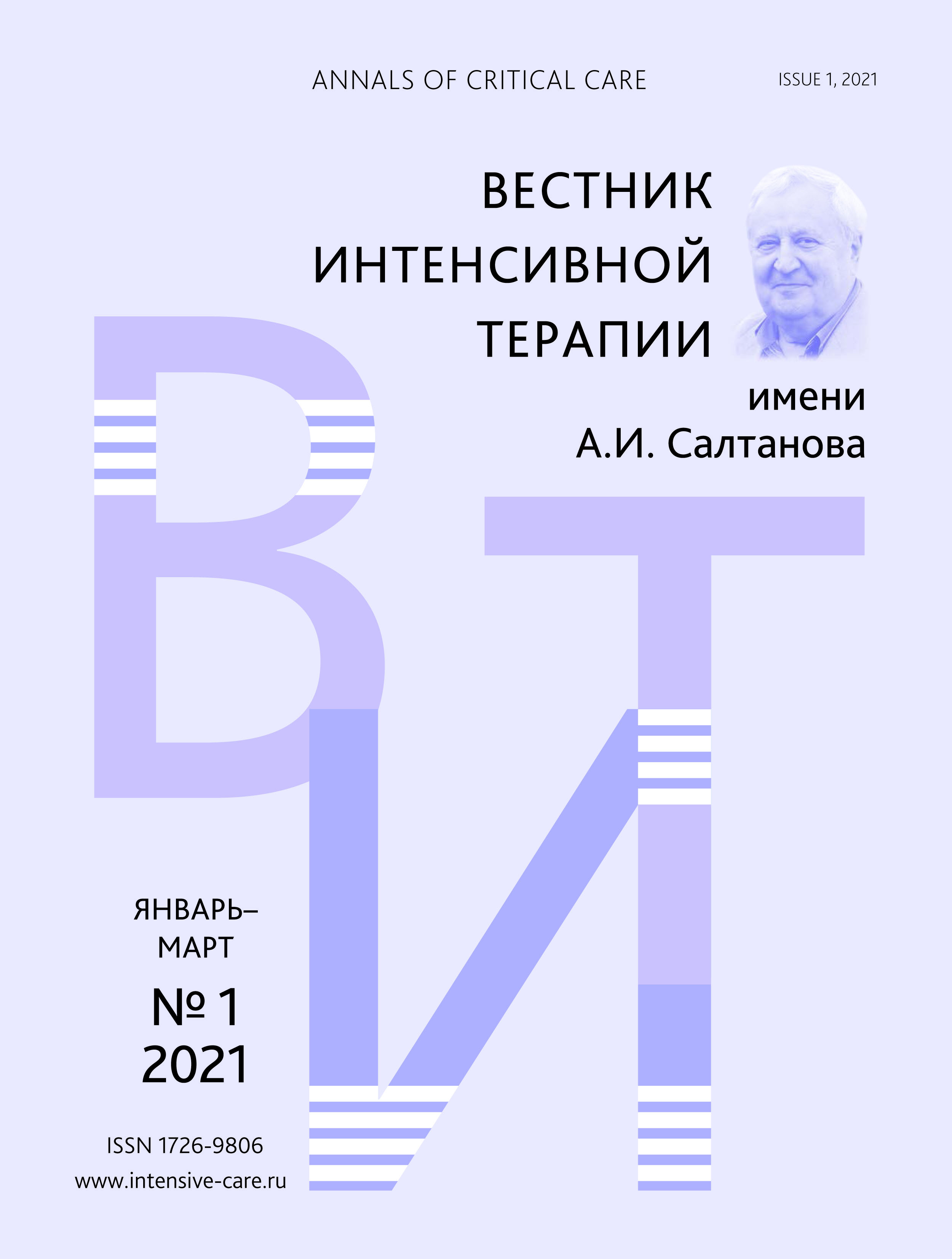Аннотация
Актуальность. По данным отечественной и мировой литературы, частота венозных тромбоэмболических осложнений в онкологии составляет в среднем 5–7 %, однако некоторые авторы указывают и большую распространенность, вплоть до 20 %. Венозные тромбоэмболии существенно увеличивают риск летального исхода в процессе лечения злокачественных опухолей. Одной из наиболее тромбоопасных локализаций опухолей является полость таза, в т. ч. и новообразования предстательной железы. Несмотря на достижения в области тромбопрофилактики и лабораторного контроля состояния системы гемостаза, данная проблема по-прежнему сохраняет свою актуальность.
Цель исследования. Определить показатели теста тромбодинамики, прогностически значимые для риска развития венозных тромбоэмболических осложнений у пациентов со злокачественным новообразованием предстательной железы, перенесших радикальную простатэктомию.
Материалы и методы. В исследование были включены 59 пациентов с диагнозом рака предстательной железы, которым предстояло оперативное лечение в объеме радикальной простатэктомии с лимфаденэктомией или без нее. Всем больным в предоперационном периоде проведен сбор анамнеза, определен риск развития венозных тромбоэмболических осложнений по шкале Caprini, выполнены лабораторные тесты (общий анализ, биохимический анализ крови, коагулограмма, уровень D-димеров), проведено ультразвуковое исследование проходимости вен нижних конечностей, тест тромбодинамики в день поступления. Фармакологическая профилактика тромбозов проводилась согласно клиническим рекомендациям American Society of Clinical Oncology. Применялся надропарин кальция, доза подбиралась с учетом массы тела больных. В послеоперационном периоде в трех контрольных точках выполнены стандартные коагуляционные тесты с определением уровня D-димеров и теста тромбодинамики. Ультразвуковой контроль проходимости вен выполнен на 3-и сутки после операции и перед выпиской пациентов (10–14-е сутки после операции).
Результаты. Частота тромбозов в раннем послеоперационном периоде в нашем исследовании составила 5 %. При анализе данных теста тромбодинамики при повышении стационарной скорости роста сгустка перед первым введением после операции или на пике действия надропарина кальция на 3-и сутки после операции выше 43 мкм/мин частота развития тромбозов существенно повышалась.
Заключение. Показатель стационарной скорости роста сгустка, превышающий значение 43 мкм/мин, ассоциировался с повышенной частотой развития венозных тромбоэмболических осложнений у данной категории больных.
Библиографические ссылки
- Никулина Н.Н., Тереховская Ю.В. Эпидемиология тромбоэмболии легочной артерии в современном мире: анализ заболеваемости, смертности и проблем их изучения. Российский кардиологический журнал. 2019;(6): 103–108. DOI: 10.15829/1560-4071-2019-6-103-108 [Nikulina N., Terekhovskaya Y. Epidemiology of pulmonary embolism in today’s context: analysis of incidence, mortality and problems of their study. Russian Journal of Cardiology. 2019; 6: 103– (In Russ.)]
- Российский статистический ежегодник. 2019. Стат.сб./Росстат. Р М., 2019. [Russian Statistical Yearbook. 2019: Stat. book/ Rosstat. R76. Мoscow, 2019. (In Russ)]
- Karimi M., Cohan N. Cancer-associated thrombosis. Open Cardiovasc Med J. 2010; 4(2): 78–82. DOI: 10.2174/1874192401004020078
- Amer M. Cancer-associated thrombosis: clinical presentation and survival. Cancer Manag Res. 2013: 165. DOI: 10.2147/CMAR.S47094
- Noble S., Pasi J. Epidemiology and pathophysiology of cancer-associated thrombosis. Br J Cancer. 2010; 102(S1): S2– DOI: 10.1038/sj.bjc.6605599
- Суворин П.А., Хороненко В.Э., Жарков П.А. идр. Профилактика венозных тромбоэмболий у онкологических больных. Онкология. Журнал им. П.А. Герцена. 2017; 6(1): 71–75. DOI: 17116/onkolog20176171-75 [Suvorin P., Khoronenko V., Zharkov P., et al. Prevention of venous thromboembolism in cancer patients. Onkologiya Zhurnal imeni PAGertsena. 2017; 6(1): 71–75. (In Russ)]
- Garcia D., Baglin T., Weitz J., et al. Parenteral anticoagulants. Chest. 2012; 141(2): e24S–e43S. DOI: 10.1378/chest.11-2291
- Wang Z., Li J., Cao Q., et al. Comparison Between Thromboelastography and Conventional Coagulation Tests in Surgical Patients With Localized Prostate Cancer. Clinical and Applied Thrombosis/Hemostasis. 2017; 24(5): 755–763. DOI: 10.1177/1076029617724229
- Halaby R., Popma C., Cohen A., et al. D-Dimer elevation and adverse outcomes. J Thromb Thrombolysis. 2014; 39(1): 55–59. DOI: 10.1007/s11239-014-1101-6
- Yu J., Li D., Lei D., et al. Tumor-Specific D-Dimer Concentration Ranges and Influencing Factors: A Cross-Sectional Study. PLoS One. 2016; 11(11): e0165390. DOI: 10.1371/journal.pone.0165390
- Lippi G., Bonfanti L., Saccenti C., et al. Causes of elevated D-dimer in patients admitted to a large urban emergency department. Eur J Intern Med. 2014; 25(1): 45–48. DOI: 10.1016/j.ejim.2013.07.012
- Olson J., Cunningham M., Higgins R., et al. D-dimer: Simple Test, Tough Problems. Arch Pathol Lab Med. 2013; 137(8): 1030–1038. DOI: 10.5858/arpa.2012-0296-CP
- Brunetti L., Wassef A., Sadek R., et al. Anticoagulant activity of enoxaparin and unfractionated heparin for venous thromboembolism prophylaxis in obese patients undergoing sleeve gastrectomy. Surgery for Obesity Related Diseases. 2019; 15(3): 363–373. DOI: 10.1016/j.soard.2018.12.014
- Rostas J., Brevard S., Ahmed N., et al. Standard Dosing of Enoxaparin for Venous Thromboembolism Prophylaxis Is Not Sufficient for Most Patients Within a Trauma Intensive Care Unit. Am Surg. 2015; 81(9): 889–892. DOI: 10.1177/000313481508100923
- Nunez J., Becher R., Rebo G., et al. Prospective Evaluation of Weight-Based Prophylactic Enoxaparin Dosing in Critically Ill Trauma Patients: Adequacy of AntiXa Levels Is Improved. Am Surg. 2015; 81(6): 605–609. DOI: 10.1177/000313481508100625
- Davies N., Harrison N., Sabra A., et al. Application of ROTEM to assess hypercoagulability in patients with lung cancer. Thromb Res. 2015; 135(6): 1075–1080. DOI: 10.1016/j.thromres.2015.03.021
- Баландина А.Н., Кольцова Е.М., Шибеко А.М. идр. Тромбодинамика: новый подход к диагностике нарушений системы гемостаза. Вопросы гематологии/онкологии и иммунопатологии в педиатрии. 2018; 17(4): 114–126. DOI: 24287/1726-1708-2018-17-4-114-126 [Balandina A.N., Koltsova E.M., Shibeko A.M., et al. Thrombodynamics: a new method to the diagnosis of hemostasis system disorders. Pediatric Hematology/Oncology and Immunopathology. 2018; 17(4): 114–126. (In Russ)]
- Буянова С.Н., Будыкина Т.С., Сибряева В.А. идр. Оценка эффективности теста тромбодинамики в диагностике нарушений системы гемостаза у хирургических гинекологических больных с высоким риском развития венозных тромбоэмболических осложнений. Российский вестник акушера-гинеколога. 2017; 17(5): 65–70. DOI: 10.17116/rosakush201717565-70 [Buyanova S., Budykina T., Sibryaeva V., et al. Evaluating the efficiency of thrombodynamics test in the diagnosis of hemostatic system disorders in gynecologic surgical patients at high risk for venous thromboembolic events. Rossiiskii vestnik akushera-ginekologa. 2017; 17(5): 65. (In Russ)]

Это произведение доступно по лицензии Creative Commons «Attribution-NonCommercial-ShareAlike» («Атрибуция — Некоммерческое использование — На тех же условиях») 4.0 Всемирная.
Copyright (c) 2021 ВЕСТНИК ИНТЕНСИВНОЙ ТЕРАПИИ имени А.И. САЛТАНОВА

